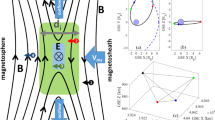Abstract
Long-range spatial correlations in the turbulent plasma of the L-2M stellarator were revealed experimentally, and their relation to the geometry of magnetic surfaces was analyzed (Plasma Phys. Control. Fusion 50, 045001 (2008)). The operation modes of the facility in which fast transport transitions in plasma are possible were studied. Upon these transitions, the turbulence level is found to decrease substantially. It is shown that long-range spatial correlations are typical of relatively narrow frequency ranges. In particular, before a transport transition, such frequency ranges are f ∼ 30–40 kHz and f ∼ 1–3 kHz. After the transition, long-range spatial correlations in the frequency range of f ∼ 30–40 kHz disappear due to a significant decrease in the turbulence level in this frequency range. At the same time, correlations in the low frequency range are retained and new correlations at frequencies of f ∼ 6-12 kHz occur. It is found that global electromagnetic oscillations in the frequency range of f ∼ 1–3 kHz are related to the m/n = 0/0 perturbation and its toroidal satellites (here, m and n are the poloidal and toroidal mode numbers, respectively). It is also shown that, after the transport transition, a three-dimensional localized electromagnetic mode at the frequency of the geodesic acoustic mode governed by the average magnetic field curvature is excited. At higher frequencies typical of a geodesic acoustic mode related to the three-dimensional curvature of the magnetic field, no long-range spatial correlations were observed both before and after the transport transition.
Similar content being viewed by others
References
M. Endler, J. Nucl. Mater. 84, 266 (1999).
G. B. Conway, Plasma Phys. Controlled Fusion 50, 124026 (2008).
G. R. Tynan, A. Fujisawa, and G. McKee, Plasma Phys. Controlled Fusion 51, 113001 (2009).
X. Garbet, Y. Idomara, L. Villard, and T. Watanabe, Nucl. Fusion 50, 043002 (2010).
V. P. Budaev, S. P. Savin, and L. M. Zelenyi, Phys. Usp. 54, 875 (2011).
P. H. Diamond, S.-I. Itoh, and K. Itoh, Modern Plasma Physics, Vol. 1: Physical Kinetics of Turbulent Plasmas (Cambridge University Press, Cambridge, 2010).
P. H. Diamond, K. Itoh, S.-I. Itoh, and T. S. Hahm, Plasma Phys. Controlled Fusion 47, R35 (2005).
A. Fudjisawa, T. Ido, A. Shimizu, et al., Nucl. Fusion 47, 718 (2008).
A. Fudjisawa, Nucl. Fusion 49, 013001 (2010).
N. Winsor, J. L. Johnson, and J. M. Dawson, Phys. Fluids 11, 2448 (1968).
T. Watari, Y. Hamada, A. Nishizawa, et al., Plasma Sci. Technol. 6, 105 (2006).
K. Hallatschek, Plasma Phys. Controlled Fusion 49, B137 (2007).
S. V. Shchepetov, Yu. V. Kholnov, and D. G. Vasilkov, JETP Lett. 91, 170 (2010).
S. V. Shchepetov, Yu. V. Kholnov, O. I. Fedyanin, et al., Plasma Phys. Controlled Fusion 50, 045001 (2008).
L. M. Kovrizhnykh and S. V. Shchepetov, Sov. J. Plasma Phys. 6, 533 (1980).
S. V. Shchepetov, Yu. V. Kholnov, and D. G. Vasil’kov, Plasma Phys. Rep. 39, 130 (2013).
Yu. V. Kholnov, Tr. IOFAN 31, 117 (1991).
G. Samorodnitsky, Found. Trends Stoch. Systems 1, 163 (2006).
B. Ph. van Milligan, E. Sanchez, T. Estrada, et al., Phys. Plasmas 2, 3017 (1995).
G. M. Batanov, A. E. Petrov, K. A. Sarksyan, et al., JETP Lett. 67, 662 (1998).
A. Fudjisawa, K. Itoh, H. Iguchi, et al., Phys. Rev. Lett. 93, 165003 (2004).
D. Lortz, Nucl. Fusion 15, 49 (1975).
L.-Z. Zheng, Phys. Lett. A 164, 424 (1992).
Author information
Authors and Affiliations
Corresponding author
Additional information
Original Russian Text © D.G. Vasil’kov, Yu.V. Kholnov, S.V. Shchepetov, 2013, published in Fizika Plazmy, 2013, Vol. 39, No. 8, pp. 694–703.
Rights and permissions
About this article
Cite this article
Vasil’kov, D.G., Kholnov, Y.V. & Shchepetov, S.V. Long-range spatial correlations in the turbulent edge plasma of the L-2M stellarator. Plasma Phys. Rep. 39, 615–623 (2013). https://doi.org/10.1134/S1063780X13080072
Received:
Accepted:
Published:
Issue Date:
DOI: https://doi.org/10.1134/S1063780X13080072




